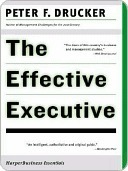More on this book
Community
Kindle Notes & Highlights
upward contribution, the more will he require fairly big continuous chunks of time. The more he switches from being busy to achieving results, the more will he shift to sustained efforts—efforts which require a fairly big quantum of time to bear fruit.
But one can at least try to limit one’s servitude to the past by cutting out those inherited activities and tasks that have ceased to promise results.
The need to slough off the outworn old to make possible the productive new is universal.
Pick the future as against the past; Focus on opportunity rather than on problem; Choose your own direction—rather than climb on the bandwagon; and Aim high, aim for something that will make a difference, rather than for something that is “safe” and easy to do.
Achievement goes to the people who pick their research priorities by the opportunity and who consider other criteria only as qualifiers rather than as determinants.
The first question the effective decision-maker asks is: “Is this a generic situation or an exception?”
All events but the truly unique require a generic solution. They require a rule, a policy, a principle.
The effective decision-maker, therefore, always assumes initially that the problem is generic. He always assumes that the event that clamors for his attention is in reality a symptom. He looks for the true problem. He is not content with doctoring the symptom alone.
The effective executive does not need to make many decisions. Because he solves generic situations through a rule and policy, he can handle most events as cases under the rule; that is, by adaptation.
The second major element in the decision process is clear specifications as to what the decision has to accomplish. What are the objectives the decision has to reach? What are the minimum goals it has to attain? What are the conditions it has to satisfy? In science these are known as “boundary conditions.” A decision, to be effective, needs to satisfy the boundary conditions. It needs to be adequate to its purpose.
The effective executive knows that a decision that does not satisfy the boundary conditions is ineffectual and inappropriate.
In fact, clear thinking about the boundary conditions is needed so that one knows when a decision has to be abandoned.
One has to start out with what is right rather than what is acceptable (let alone who is right) precisely because one always has to compromise in the end.
For there are two different kinds of compromise. One kind is expressed in the old proverb: “Half a loaf is better than no bread.” The other kind is expressed in the story of the Judgment of Solomon, which was clearly based on the realization that “half a baby is worse than no baby at all.” In the first instance, the boundary conditions are still being satisfied. The purpose of bread is to provide food, and half a loaf is still food. Half a baby, however, does not satisfy the boundary conditions. For half a baby is not half of a living and growing child. It is a corpse in two pieces.
Converting the decision into action is the fourth major element in the decision process.
Who has to know of this decision? What action has to be taken? Who is to take it? And what does the action have to be so that the people who have to do it can do it? The
The only rigorous method, the only one that enables us to test an opinion against reality, is based on the clear recognition that opinions come first—
“What do we have to know to test the validity of this hypothesis?” “What would the facts have to be to make this opinion tenable?”
Finding the appropriate measurement is thus not a mathematical exercise. It is a risk-taking judgment.
Unless one has considered alternatives, one has a closed mind.
insistence on disagreement.
disagreement is needed to stimulate the imagination.
PERT (Program Evaluation and Review Technique) which aims at providing a road map for the critical tasks in a highly complex program such as the development and construction of a new space vehicle.
As long as we can handle the events on the operating level by adaptation rather than by thinking, by “feel” rather than by knowledge and analysis, operating people—in government, in the military, or in business—will be untrained, untried, and untested when, as top executives, they are first confronted with strategic decisions.
taken organizational performance and executive performance to be goals in and by themselves.
Effective decision-making requires both procedure and analysis, but its essence is an ethics of action. There is much more to the self-development of an executive than his training
training oneself to be an effective executive
He needs opportunity, he needs achievement, he needs fulfillment, he needs values. Only by making himself an effective executive can the knowledge worker obtain these satisfactions.


